Banksy is an elusive street artist whose true identity remains a mystery, fueling curiosity worldwide. Known for his provocative stencil art, he addresses social and political issues, using urban environments to amplify his messages. His anonymity protects him legally while boosting his rebellious persona. From high-profile sales to inspiring future artists, Banksy’s influence is profound. To uncover more about his secretive life, creative techniques, and societal impact, keep exploring his intriguing story.
Key Takeaways
- Banksy remains anonymous, with his true identity unconfirmed, fueling global intrigue and speculation.
- His distinctive stencil technique and urban integration create provocative, socially charged artworks.
- His art addresses political, social, and environmental issues, sparking widespread public and cultural discourse.
- Banksy’s high-value auction sales and gallery presence have elevated street art’s legitimacy and market value.
- His anonymity and rebellious persona symbolize resistance, inspiring activism and challenging societal norms.
The Enigmatic Identity of Banksy
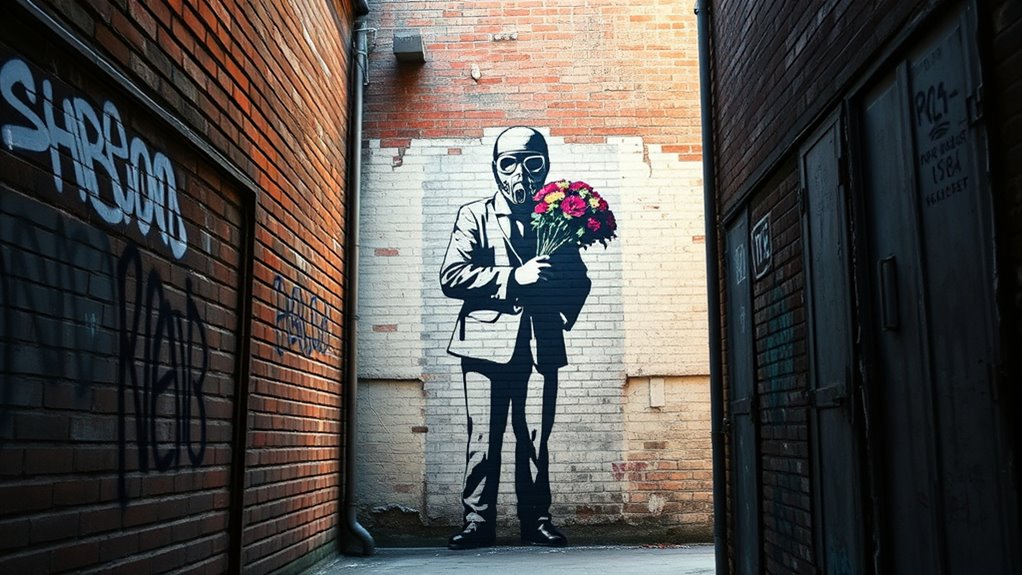
Banksy’s true identity remains one of the most enthralling mysteries in the art world, fueling speculation and intrigue worldwide. Many believe he’s Robin Gunningham, a former Bristol Cathedral School student, supported by geographic profiling linking his artwork locations to places associated with Gunningham. The Mail on Sunday first suggested this in 2008, but Banksy denied it. A rare 2003 audio clip reveals him calling himself ‘Robbie,’ close to Robin. Despite efforts to unmask him, legal teams have delayed or prevented disclosures, and even his family is rumored to be in the dark. Media outlets continue to speculate, especially about Bristol ties, adding to the mystique. This secrecy boosts his allure, making Banksy an enduring symbol of artistic anonymity, and it has also contributed to a proliferation of urban art worldwide. The ongoing mystery surrounding his identity continues to contribute to his legendary status and global fascination. Notably, the mystery surrounding his persona has helped preserve the rebellious spirit that defines his work. Additionally, the anonymous nature of his identity has played a crucial role in shaping the perception and impact of his art.
Artistic Techniques and Style
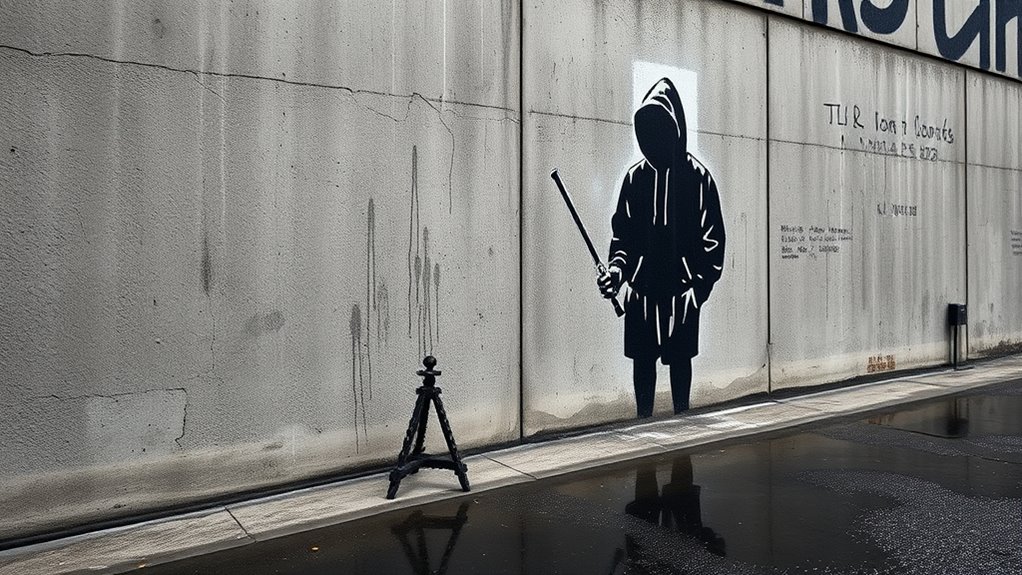
You notice how Banksy uses stenciling to quickly reproduce detailed images on city walls, making his work efficient and precise. His layered stencils add depth, while the urban environment becomes part of the message, enhancing storytelling. This combination of technique and setting helps his art communicate powerful social commentary with clarity and impact. He often employs monochrome palettes to focus attention on the narratives and emotions conveyed.
Stenciling Methodology and Impact
Stenciling has revolutionized street art by enabling artists to produce detailed images quickly and consistently in public spaces. It involves creating templates with intricate cut-outs, allowing for rapid reproduction of designs. Originating from the French ‘pochoir’ technique, it offers precision and efficiency, making it ideal for social commentary and satire. Banksy’s use of stencils combines mechanical accuracy with layered storytelling, creating striking visuals in monochrome palettes. The technique also facilitates safe, swift application, helping artists avoid detection. Its ability to reproduce prints extends the reach of their messages globally. Banksy’s mastery of stenciling elevates street art’s reputation and influence, as shown in iconic works like “Girl with Balloon” and “Kissing Coppers.” The table below summarizes key aspects of the technique:
| Aspect | Description | Impact |
|---|---|---|
| Technique | Intricate cut-outs for quick application | Precision and efficiency |
| Origin | French ‘pochoir’ technique | Cultural and historical roots |
| Artistic Style | Sharp satire, layered narratives | Visual impact and storytelling |
| Influence | Widely adopted, enhances social messages | Global recognition and legacy |
Urban Element Integration
How does urban environment shape street art? You notice Banksy’s work is carefully placed to interact with existing urban features like walls, pipes, and signs, making each piece feel connected to its surroundings. The environment amplifies the message, turning everyday surfaces into storytelling tools. Weathered textures and decay are embraced, adding depth and rawness that reflect the city’s gritty reality. He often chooses locations that contrast or complement his themes, such as near government buildings or conflict zones, making the art part of daily life. Banksy also incorporates urban fixtures like manhole covers or cracks into his designs, transforming them into meaningful elements. This seamless integration makes his art feel like an organic part of the city, engaging passersby in a shared urban narrative. His mastery of stencil techniques allows him to execute detailed images quickly, which is crucial for his illicit work and site-specific installations. Additionally, the urban environment’s ever-changing nature challenges artists to adapt their work, making each piece unique and contextually relevant. The influence of the urban environment extends beyond aesthetics, often conveying social and political messages that resonate deeply with city dwellers. Moreover, the urban landscape offers a diverse array of surfaces and spaces that inspire creative experimentation and innovation. Recognizing how urban decay can serve as a canvas, many artists harness the beauty found in neglected areas to enhance their visual storytelling. Furthermore, modern urban infrastructure like lighting and signage can be integrated into artworks to create interactive and dynamic pieces.
Themes and Messages Conveyed
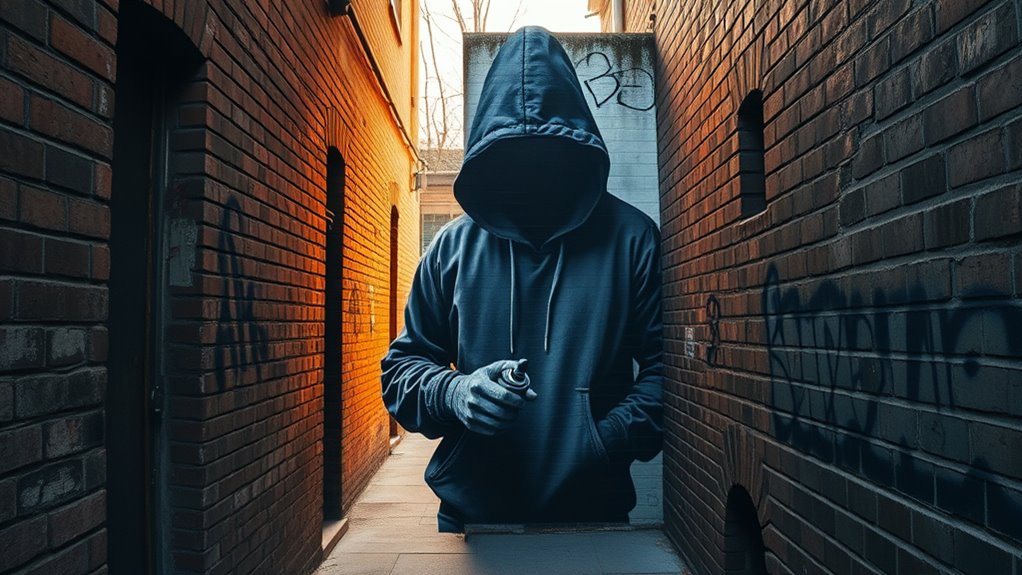
Banksy’s work uses powerful visual irony to highlight political and social issues, making complex messages instantly recognizable. You’ll notice how he combines imagery and text to challenge authority, consumerism, and injustice. His art invites you to think critically about the world around you and question the status quo. His artworks often contain hidden symbols that deepen the meaning and provoke further reflection. Additionally, the use of public spaces emphasizes accessibility and the democratization of art, breaking down traditional barriers between artwork and viewers. Many of his pieces are created during specific hours, which adds an element of spontaneity and surprise. The element of anonymity enhances the impact of his work, allowing viewers to focus on the message rather than the artist’s identity. Incorporating artistic techniques further amplifies the effectiveness of his visual commentary. Moreover, the economic impact of his art frequently sparks discussions about value and authenticity in the art world.
Political and Social Commentary
Have you ever noticed how street art can serve as a powerful tool for political and social commentary? Banksy’s work often addresses urgent issues through provocative imagery and messages.
- His anti-war pieces like CND Soldiers and *Napalm* critique violence and conflict. These works challenge viewers to reflect on the human cost of war and the importance of peace.
- Murals on the West Bank Wall draw attention to the Israeli-Palestinian struggle and humanize those affected. Recognizing the societal impact of such art helps in understanding its role in fostering empathy and awareness.
- His satirical art, such as Devolved Parliament questions political systems using animals and humor. Such pieces exemplify the influence of art as activism in raising critical societal questions.
- Understanding how emotional intelligence influences public perception can deepen appreciation of Banksy’s ability to evoke empathy and reflection through his art. This skill enhances the effectiveness of his messages in prompting social change.
- The power of spiritual energy in art can foster a deeper emotional connection, which is often utilized by artists like Banksy to evoke introspection and societal awareness. Additionally, the element of cultural significance amplifies the resonance of his work across different communities.
Banksy’s anonymity amplifies his messages, allowing the art to speak for itself without personal bias. His work engages the public directly, making complex issues more accessible and encouraging reflection on injustice, inequality, and resistance. Through his art, Banksy influences societal conversations globally.
Use of Visual Irony
Banksy’s art masterfully employs visual irony to challenge viewers’ perceptions and expectations. You notice how he uses everyday scenes and objects with unexpected twists, prompting you to think deeper. For example, he combines innocence with critique, like children placed in adult or controversial contexts, making his message striking and memorable. His choice of public spaces amplifies this impact, ensuring the irony is unavoidable and accessible to all. Banksy often appropriates familiar symbols—logos, signs, pop culture icons—and twists their meanings to highlight contradictions within modern life, consumerism, and authority. His role reversals, like a sunflower-filled gas mask or a balloon in “No Future,” subvert stereotypes, urging you to question assumptions. Layered and multifaceted, his irony sparks dialogue without direct confrontation, encouraging personal reflection. Recognizing the public space he employs underscores the importance of context in conveying his messages effectively. Understanding the visual irony techniques he uses enhances your appreciation of his work’s complexity and intent. Additionally, exploring figurative language techniques reveals how Banksy’s use of metaphors and symbolism deepens the interpretive richness of his art, inviting viewers to engage more thoughtfully with his messages.
Milestones in His Artistic Journey
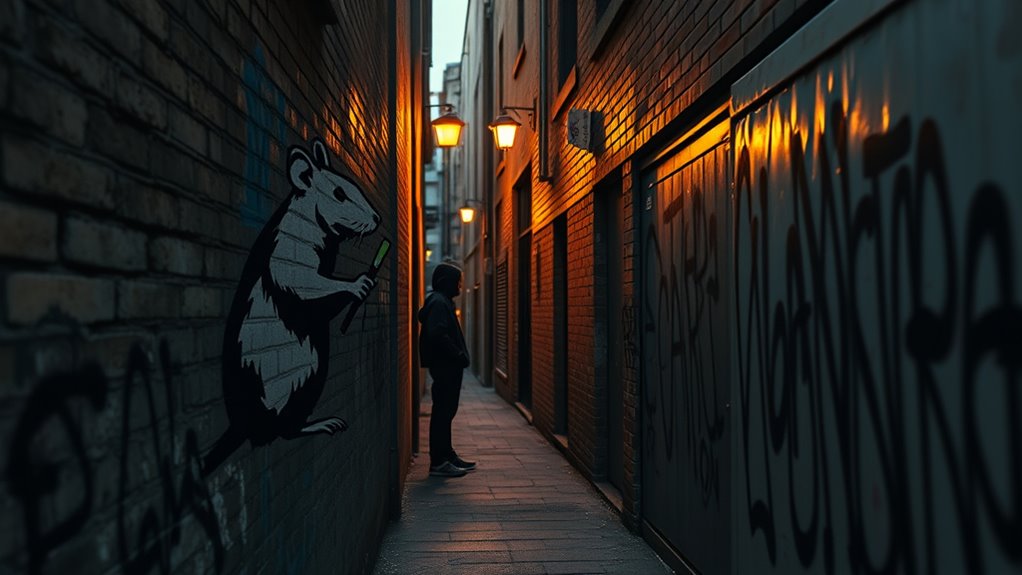
- Participated in Bristol’s graffiti scene and formed early collaborations
- Shifted to stencil art for efficiency and anonymity
- Published his first book and gained global recognition
Impact on the Art World and Society
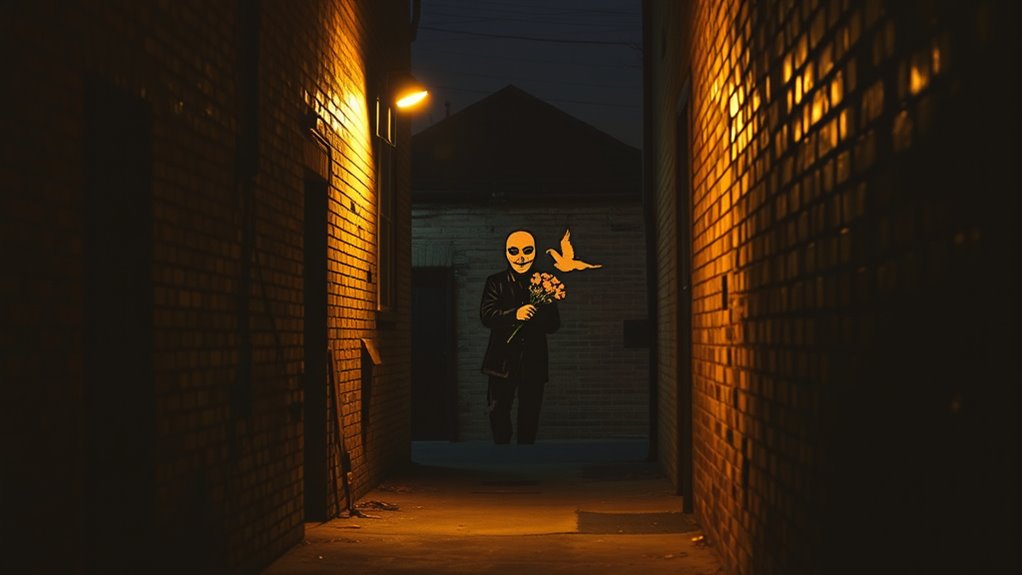
Banksy has revolutionized the art world by elevating street art from illicit graffiti to a respected form of fine art. His work attracts millions at auctions, legitimizing street art within high-value markets. This shift has opened doors for urban artists to gain gallery and auction recognition, transforming public murals into celebrated art pieces. His art often tackles social and political issues, sparking global debates and inspiring community engagement. The table below highlights his influence:
| Impact Area | Key Effect | Examples |
|---|---|---|
| Art Recognition | Street art gained legitimacy | Auction sales, galleries |
| Societal Engagement | Raises awareness and debate | Political murals, donations |
| Economic Impact | Boosts local tourism and markets | Bristol, urban revitalization |
| Artistic Inspiration | Inspires new artists and styles | KAWS, Invader, street art growth |
This influence has reshaped both society and the art industry profoundly.
Commercial Success and Market Presence
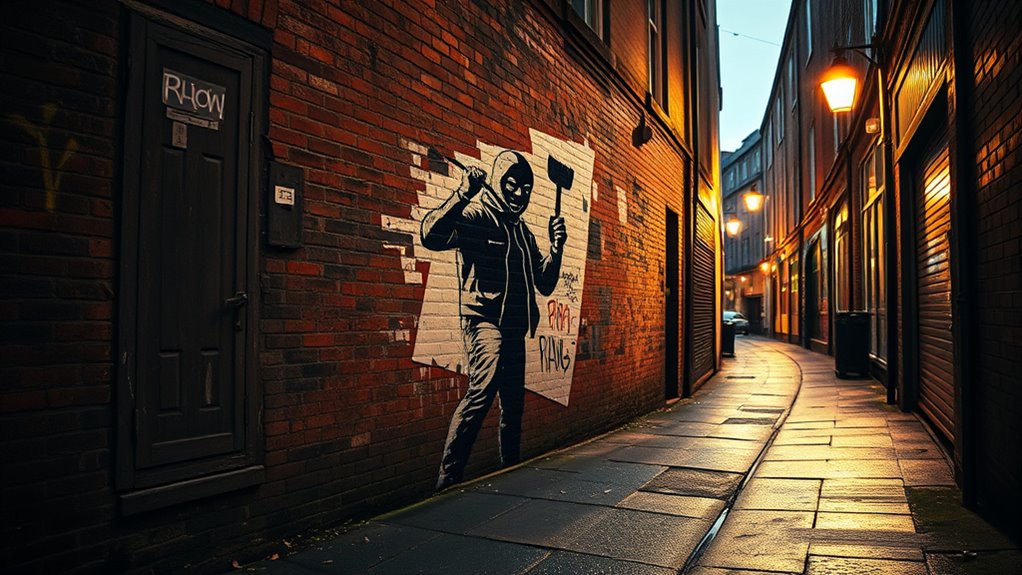
The rise of street art’s legitimacy has paved the way for Banksy’s works to achieve remarkable commercial success. Since his first dedicated auction in 2016, his market has expanded rapidly, with sales at Sotheby’s, Christie’s, and Artcurial. Notable highlights include a 2019 sale of a chimpanzee invasion of the House of Commons for £9.9 million and Christie’s 2021 auction netting over £3.5 million. This growth has pushed Banksy’s average sale price beyond Andy Warhol’s, reflecting his rising dominance.
Banksy’s market value soars, surpassing Warhol, as dedicated auctions fuel global demand and cultural influence.
You should note:
- Dedicated auctions set performance benchmarks and attract global interest
- Market saturation challenges demand fluctuation and volatility
- Banksy’s work significantly boosts local economies and cultural tourism
The Power of Anonymity and Public Persona
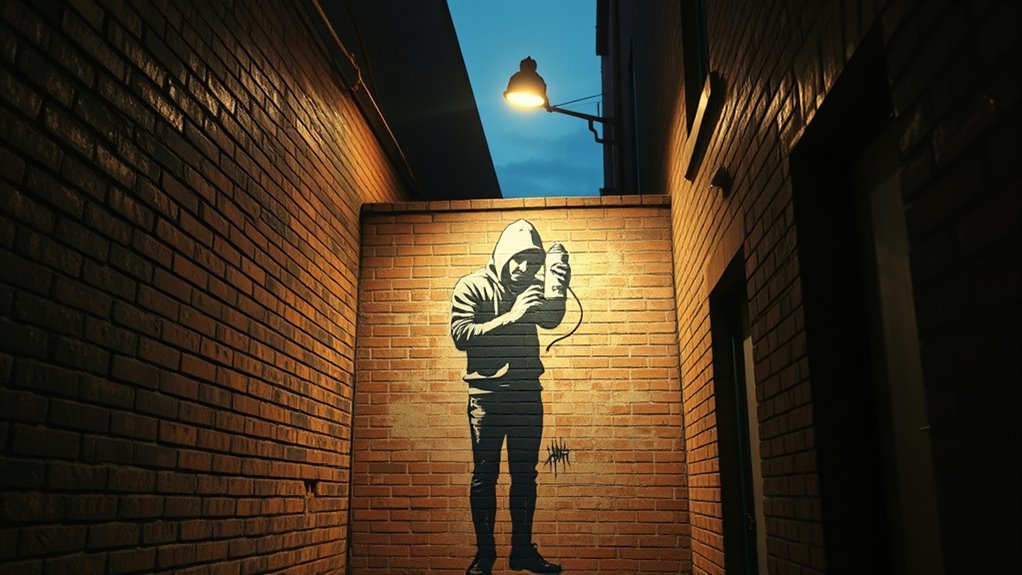
Maintaining anonymity has become a powerful tool for street artists like Banksy, shaping both his public image and the impact of his work. It shields him from legal trouble, allowing him to create provocative art without fear of prosecution. Anonymity also fuels curiosity, turning his identity into a mysterious symbol that draws public interest. It keeps the focus on his art rather than personal details, emphasizing societal messages over individual fame. This secrecy fosters a rebellious persona, making Banksy a symbol of resistance. His use of masks and veiled interviews reinforce his stance on identity. By working undercover and using pseudonyms, he maintains control over his image. Ultimately, his anonymity amplifies his cultural influence, allowing his art to speak louder than any personal notoriety.
Legacy and Influence on Future Generations
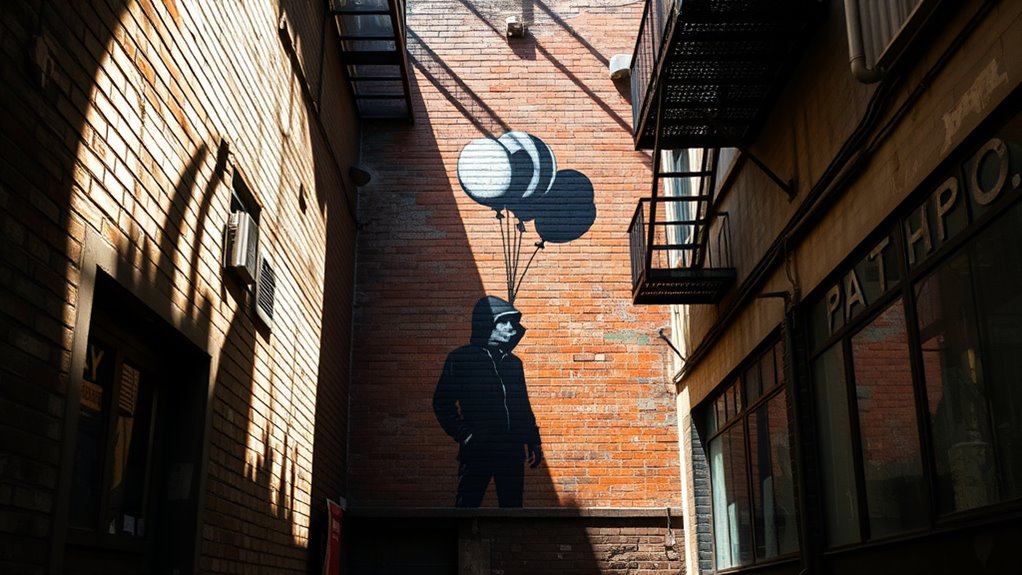
Banksy’s innovative approach to street art has permanently reshaped the artistic landscape, inspiring countless future artists and activists to see public spaces as legitimate canvases. His work has elevated street art from vandalism to a respected art form, encouraging new generations to challenge societal norms through provocative visuals and social commentary. You’ll find his influence in the way artists now use public spaces to communicate powerful messages and push creative boundaries. His legacy also acts as a catalyst for social change, inspiring activism and resistance worldwide. Banksy’s art continues to spark dialogue, making you question perceptions of art, activism, and freedom.
- Legitimization of street art as a true art form
- Inspiration for new artists and social movements
- Continued cultural and political influence
Frequently Asked Questions
Has Banksy Ever Revealed His True Identity Publicly?
You wonder if Banksy has ever revealed his true identity publicly. Up to now, he hasn’t officially confirmed who he is. Despite rare interviews and clues like descriptions and possible names, Banksy remains anonymous. This mystery fuels public fascination and adds to his art’s impact. You can’t find any verified public reveal, and it seems he prefers to keep his identity hidden to protect his artistic persona and the message behind his work.
What Are the Main Materials Banksy Uses in His Street Art?
Did you know that spray paint is used in over 90% of street art creations? When you look at Banksy’s work, you’ll notice he primarily uses stencils made from cardboard or acetate sheets, which allow for precise images. He often layers different stencils with various colors, applying them to concrete walls or other surfaces. Recycled and unconventional materials also appear, helping him deliver powerful social messages anonymously and effectively.
How Does Banksy Choose Locations for His Artwork?
When choosing locations for your artwork, you prioritize sites that maximize visibility and social impact. You research areas with cultural or political significance, ensuring they support your message. Accessibility and the ability to work secretly matter, so you pick spots where you can create without being detected. You also consider how long the piece will stay visible, aiming for locations that foster community engagement and inspire reflection on important issues.
Are Banksy’S Works Primarily Short-Term or Permanent?
Ever wonder if Banksy’s art is meant to last? His works are mostly short-term, intentionally designed to be temporary, aligning with street art’s rebellious roots. You’ll see murals that survive for years, but most disappear quickly due to vandalism, weather, or removal. Do you think the fleeting nature makes his art more powerful or more frustrating? Either way, it sparks debate about preservation, value, and the true essence of street art.
How Does Banksy Fund His Art Projects and Activism?
You might wonder how Banksy funds his art projects and activism. He sells artwork directly to private collectors and through private sales, avoiding gallery commissions. His works also resell on the secondary market, increasing in value and generating revenue. Limited editions and collaborations boost exclusivity and income. Additionally, proceeds from sales support large-scale projects and social causes, while his provocative public works and social media presence help promote his mission and attract funding.
Conclusion
You might be surprised to learn that Banksy’s artworks have sold for over $12 million, highlighting his significant impact. His anonymity fuels curiosity and preserves the mystery, making each piece more powerful. By blending street art with provocative messages, you see how he challenges societal norms and inspires future artists. Ultimately, Banksy’s influence endures, proving that true art can thrive outside traditional galleries and leave a lasting mark on society.









